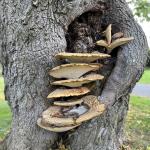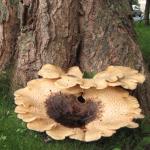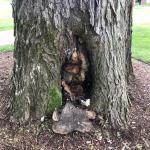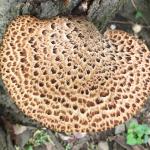Trunk Rot caused by Cerioporus squamosus (Dryad's Saddle)
Pathogen
The native fungal pathogen Cerioporus squamosus (formerly Polyporus) is known as Dryad’s Saddle.
Hosts
Cerioporus has a broad host range among deciduous hardwoods but is most common on maple (Acer), poplar/aspen (Populus), willow (Salix) and elm (Ulmus) (Sinclair and Lyon 2005).
Symptoms & Signs
Dryad’s Saddle causes a white trunk rot within infected trees. Advanced decay can appear spongy to stringy with numerous black zone lines demarcating the advancing growth (Schwarze et al. 2000). Over time, cavity formation within infected trees is common (Sinclair and Lyon 2005, Luley 2022). Like other trunk rot pathogens, Cerioporus is believed to establish primarily through wounds. These can include large pruning cuts, broken branches, cankers, and significant physical wounds. Cerioporus produces one to several large, fleshy, upward developing, fan-shaped mushrooms. They develop on a thick stalk directly from infected trunks. Typically, they occur within or close to the wounds that facilitated the infection. The upper surface of the mushroom (pileus) is cream- to tan-colored with concentric brown to dark brown scales. In some cases, the surface has a glossy or waxy appearance. The underside (hymemium) is white with large pores that extend down onto the stalk. One interesting feature of Cerioporus is that the mushrooms can appear in the spring (mid-May to mid-June) and autumn (September to October).
Management
Scout for and document the occurrence of Cerioporus mushrooms on landscape trees. Trees with known infections should be carefully evaluated to better understand the distribution and extent of decay. The damage may be localized around the wound used to colonize the tree and the presence of fruiting bodies does not automatically indicate removal (Luley 2022). However, destruction of the ray cells in the xylem can make trees more susceptible to stem failure by transverse fracturing (Schwarze et al. 2000). Also, because advanced infections often result in cavity formation, a thorough risk assessment should take place when numerous mushrooms are present on the trunk. When Cerioporus is confirmed on a tree, careful consideration should be made about large pruning cuts on neighboring trees that are susceptible to infection. Whenever possible, attempts should be made to protect deciduous hardwoods from needless trunk wounds and cankers that could serve as infection sites.
References
Luley, CJ. 2022. Cerioporus squamosus. In: Wood Decay Fungi Common to the Northeast & Central United States, 2nd Edition. Urban Forest Diagnostics LLC, Naples, NY. Pp. 118–119.
Schwarze FWMR, Engels J, and Mattheck C. 2000. Fungal Strategies of Wood Decay in Trees. Springer, Berlin, Germany.
Sinclair WA. and Lyon, HH. 2005. Diseases of Trees and Shrubs, 2nd edn. Cornell University Press, Ithaca, NY.





